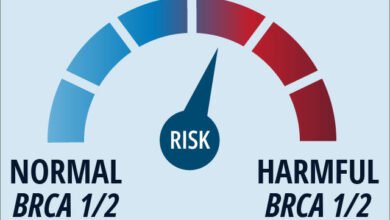Overview on the Management of Essential Thrombocythemia and Polycythemia Vera

Transcript:
Rami Komrokji, M.D.: Once we establish a diagnosis, our next step is thinking of the risk of a disease, because as you mentioned, those diseases are serious, but the risks vary. Maybe you can tell us about the next step once we establish a diagnosis. How do you think of the risks of those diseases, because each of them is probably a spectrum?
Ruben Mesa, M.D.: I think it’s an excellent point, and there was a great description on how we diagnose the disease. Both Dr. Komrokji and I, as treating physicians, are always trying to think what our goal of treatment is, and then we’ll discuss in a moment what the treatments themselves are. Our goals are to try to make these diseases as invisible from your life as possible. That includes trying to decrease risk of the disease harming you, as well as decrease the impact that the disease is having on you on a daily basis. To do this, we try to assess two things. The first is the risk with the disease. When physicians think of risk, we think of the risk of something happening that we don’t want to happen. With ET (essential thrombocythemia) and PV (polycythemia vera), that is primarily around the risk of a blood clot occurring when we don’t want it to occur, which we usually do not, or unexpected bleeding. We typically do not think in general terms that ET or PV are necessarily life-shortening diseases. However, if complications occur, they can always become life-threatening. In general, if we control that risk of blood clots and bleeding, they’re not life-threatening. Myelofibrosis can be life-threatening, but it’s quite variable with individuals having quite a wide range of experience with myelofibrosis. We have made scores that we’re able to calculate based on features of the blood, the bone marrow, genetics, and your overall health and blood counts to get a sense of the disease. The second is around the burden of disease. Is the disease giving you symptoms? Has there been a blood clot in the past that has impacted your health in some way? There are times that patients with PV, for example, can have a blood clot that goes near the liver that can have implications in terms of their health. Or are there difficult symptoms: night sweats, fevers, fatigue, weight loss, severe itching? Maybe there are not, but if there are, how do we correct them? We try to assess both risk and disease burden. Again, we think of ET and PV somewhat in a group in terms of what we’re trying to control, and myelofibrosis is in a slightly different zone. Rami (Komrokji, M.D.), with perhaps that as a platform, why don’t you start taking us through how we address treatment with ET and PV first?
Rami Komrokji, M.D.: Absolutely. You set the stage well for discussing the goals. When we’re thinking of the goals, in my mind, we are thinking of three major things. First, elevating the symptoms. Those diseases could be associated with symptoms. Then, as you mentioned earlier, those diseases are associated with the risk of clotting. That’s probably the major consequence in the first 10 or 20 years of the disease course in PV and ET. Finally, maybe we can alter the natural history of this disease or stall progression of the disease, because both essential thrombocythemia and polycythemia vera can progress to myelofibrosis, and all of those diseases can progress to AML (acute myeloid leukemia). Our treatment goals, or what we are thinking of, is in all those elements.
Now, the cure for many of the diseases we deal with is something called allogeneic stem cell transplant, which, in ET or PV, the risk outweighs the benefit because those patients have excellent survival. The goals of the treatment are mostly geared to reduce the risk of clotting and to improve the symptoms for patients. For that, we follow the risk assessment we discussed. [For] patients who are considered higher risk typically by prior history of a clot or sometimes by age, nowadays we look at certain molecular profiles, like the JAK2 mutation, for example, versus the calreticulin mutation in ET, at least. Sometimes we look at the white blood cell count, and we tailor the treatment accordingly. In essential thrombocythemia and PV, I think both patient groups benefit from baby aspirin use because that had been shown to decrease the risk of clotting in both diseases. Then, in patients who are deemed to be higher risk either by age or by prior clotting, sometimes we would use therapies called cytoreductive therapies to control the counts and decrease the risk of clotting. In polycythemia vera, patients may undergo a procedure called phlebotomy, which is taking blood from the patient. The idea of that is to decrease this red blood cell production by making the patient iron deficient to slow the production of the red blood cells, because it has been shown that if we tightly control the blood counts, we look at the hematocrit, which is another way to measure the volume of the red blood cells. Studies have shown if we continuously bring that number below 45, then the risk of clotting strokes is less, so patients may have phlebotomies. If patients are not higher risk in PV, they would have baby aspirin and phlebotomy. In ET, essential thrombocythemia, if patients are not higher risk, sometimes we will just observe those patients with no need for treatment or maybe just baby aspirin. In the two higher-risk groups, if we are going for cytoreductive therapy, there are different options or choices for those patients. Historically, mostly we’ve used a pill or chemotherapy called hydroxyurea that’s efficient at decreasing the blood counts and controlling them. We have newer treatments such as the interferon-based therapies like the ROPEG (ropeginterferon alfa-2b) that are approved by the FDA (Food and Drug Administration) for PV, but they’re used in patients with essential thrombocythemia as well. Those treatments are called cytoreductive, with the aim of controlling the blood counts. Again, in PV, the goal is to bring that hematocrit under control. If patients don’t have risk factors, they’re just getting baby aspirin and phlebotomy. If they have risk factors, then we are introducing cytoreductive therapy. Later on we’ll discuss more about the emerging role of pegylated interferon, or ROPEG, in those diseases. In patients with essential thrombocythemia, if they don’t have risk factors, maybe baby aspirin is enough. If they have risk factors, then we do the cytoreductive therapy. There is really no good correlation in essential thrombocythemia with the platelet counts between where we start and how much we need to bring it down. Typically, we like to control the counts to (fall within) a normal range, but the correlation with the clotting events and the platelet counts is not as good as with polycythemia vera with the red blood cells.
Transcript edited for clarity.
Source link
#Overview #Management #Essential #Thrombocythemia #Polycythemia #Vera



